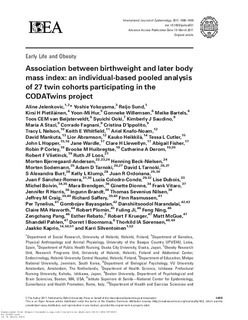| dc.contributor.author | Jelenkovic, Aline | |
| dc.contributor.author | Yokoyama, Yoshie | |
| dc.contributor.author | Sund, Reijo | |
| dc.contributor.author | Pietiläinen, Kirsi H. | |
| dc.contributor.author | Hur, Yoon-Mi | |
| dc.contributor.author | Willemsen, Gonneke | |
| dc.contributor.author | Bartels, Meike | |
| dc.contributor.author | van Beijsterveldt, Toos C. E. M. | |
| dc.contributor.author | Ooki, Syuichi | |
| dc.contributor.author | Saudino, Kimberly J. | |
| dc.contributor.author | Stazi, Maria A. | |
| dc.contributor.author | Fagnani, Corrado | |
| dc.contributor.author | D'Ippolito, Cristina | |
| dc.contributor.author | Nelson, Tracy L. | |
| dc.contributor.author | Whitfield, Keith E. | |
| dc.contributor.author | Knafo-Noam, Ariel | |
| dc.contributor.author | Mankuta, David | |
| dc.contributor.author | Abramson, Lior | |
| dc.contributor.author | Heikkila, Kauko | |
| dc.contributor.author | Cutler, Tessa L. | |
| dc.contributor.author | Hopper, John L. | |
| dc.contributor.author | Wardle, Jane | |
| dc.contributor.author | Llewellyn, Clare H. | |
| dc.contributor.author | Fisher, Abigail | |
| dc.contributor.author | Corley, Robin P. | |
| dc.contributor.author | Huibregtse, Brooke M. | |
| dc.contributor.author | Derom, Catherine A. | |
| dc.contributor.author | Vlietinck, Robert F. | |
| dc.contributor.author | Loos, Ruth J. F. | |
| dc.contributor.author | Bjerregaard-Andersen, Morten | |
| dc.contributor.author | Beck-Nielsen, Henning | |
| dc.contributor.author | Sodemann, Morten | |
| dc.contributor.author | Tarnoki, Adam D. | |
| dc.contributor.author | Tarnoki, David L. | |
| dc.contributor.author | Burt, S. Alexandra | |
| dc.contributor.author | Klump, Kelly L. | |
| dc.contributor.author | Ordonana, Juan R. | |
| dc.contributor.author | Sánchez-Romera, Juan F. | |
| dc.contributor.author | Colodro-Conde, Lucia | |
| dc.contributor.author | Dubois, Lise | |
| dc.contributor.author | Boivin, Michel | |
| dc.contributor.author | Brendgen, Mara | |
| dc.contributor.author | Dionne, Ginette | |
| dc.contributor.author | Vitaro, Frank | |
| dc.contributor.author | Harris, Jennifer Ruth | |
| dc.contributor.author | Brandt, Ingunn | |
| dc.contributor.author | Nilsen, Thomas Sevenius | |
| dc.contributor.author | Craig, Jeffrey M. | |
| dc.contributor.author | Saffery, Richard | |
| dc.contributor.author | Rasmussen, Finn | |
| dc.contributor.author | Tynelius, Per | |
| dc.contributor.author | Bayasgalan, Gombojav | |
| dc.contributor.author | Narandalai, Danshiitsoodol | |
| dc.contributor.author | Haworth, Claire M.A. | |
| dc.contributor.author | Plomin, Robert | |
| dc.contributor.author | Ji, Fuling | |
| dc.contributor.author | Ning, Feng | |
| dc.contributor.author | Pang, Zengchang | |
| dc.contributor.author | Rebato, Esther | |
| dc.contributor.author | Krueger, Robert F. | |
| dc.contributor.author | McGue, Matt | |
| dc.contributor.author | Pahlen, Shandell | |
| dc.contributor.author | Boomsma, Dorret I. | |
| dc.contributor.author | Sørensen, Thorkild I.A. | |
| dc.contributor.author | Kaprio, Jaakko | |
| dc.contributor.author | Silventoinen, Karri | |
| dc.date.accessioned | 2018-04-18T11:40:12Z | |
| dc.date.available | 2018-04-18T11:40:12Z | |
| dc.date.created | 2018-01-08T10:59:40Z | |
| dc.date.issued | 2017 | |
| dc.identifier.citation | International Journal of Epidemiology. 2017, 46 (5), 1488-1498. | |
| dc.identifier.issn | 0300-5771 | |
| dc.identifier.uri | http://hdl.handle.net/11250/2494748 | |
| dc.description.abstract | Background: There is evidence that birthweight is positively associated with body mass index (BMI) in later life, but it remains unclear whether this is explained by genetic factors or the intrauterine environment. We analysed the association between birthweight and BMI from infancy to adulthood within twin pairs, which provides insights into the role of genetic and environmental individual-specific factors. Methods: This study is based on the data from 27 twin cohorts in 17 countries. The pooled data included 78 642 twin individuals (20 635 monozygotic and 18 686 same-sex dizygotic twin pairs) with information on birthweight and a total of 214 930 BMI measurements at ages ranging from 1 to 49 years. The association between birthweight and BMI was analysed at both the individual and within-pair levels using linear regression analyses. Results: At the individual level, a 1-kg increase in birthweight was linearly associated with up to 0.9 kg/m(2) higher BMI (P < 0.001). Within twin pairs, regression coefficients were generally greater (up to 1.2 kg/m(2) per kg birthweight, P < 0.001) than those from the individual-level analyses. Intra-pair associations between birthweight and later BMI were similar in both zygosity groups and sexes and were lower in adulthood. Conclusions: These findings indicate that environmental factors unique to each individual have an important role in the positive association between birthweight and later BMI, at least until young adulthood. | |
| dc.language.iso | eng | |
| dc.relation.uri | https://academic.oup.com/ije/article/46/5/1488/3074983 | |
| dc.title | Association between birthweight and later body mass index: an individual-based pooled analysis of 27 twin cohorts participating in the CODATwins project | |
| dc.type | Peer reviewed | |
| dc.type | Journal article | |
| dc.description.version | publishedVersion | |
| dc.source.pagenumber | 1488-1498 | |
| dc.source.volume | 46 | |
| dc.source.journal | International Journal of Epidemiology | |
| dc.source.issue | 5 | |
| dc.identifier.doi | 10.1093/ije/dyx031 | |
| dc.identifier.cristin | 1537460 | |
| cristin.unitcode | 7502,5,2,0 | |
| cristin.unitcode | 7502,5,3,0 | |
| cristin.unitname | Genetikk og bioinformatikk | |
| cristin.unitname | Helseundersøkelser | |
| cristin.ispublished | true | |
| cristin.fulltext | original | |
| cristin.qualitycode | 2 | |
